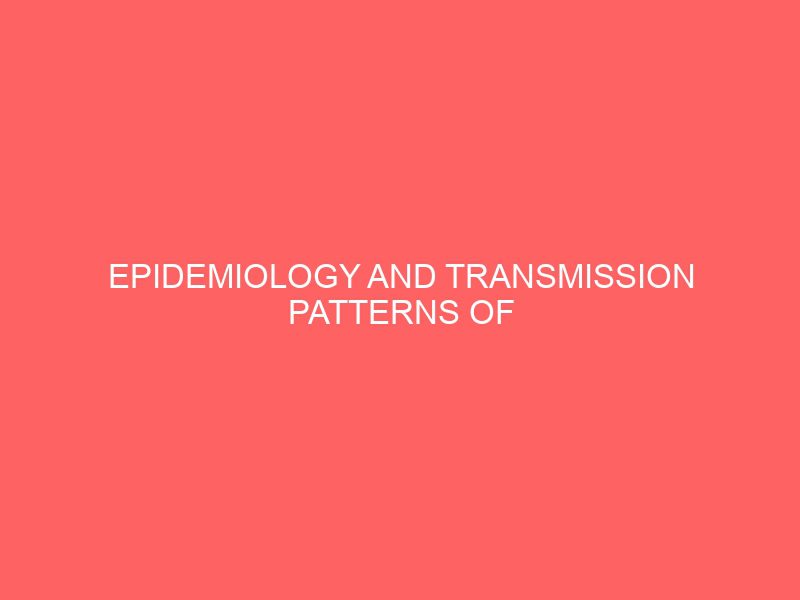Description
CHAPTER ONE
INTRODUCTION
1.1 Background of the Study
This research is on EPIDEMIOLOGY AND TRANSMISSION PATTERNS OF Schistosoma haematobium INFECTION. Schistosomiasis also known as Bilharziasis is a parasitic disease caused by infection from one of species of parasitic trematodes (Flukes) of the genus Schistosoma (Noble and Glem, 1982). The worm was discovered by Theodore Bilharz (a German pathologist) while performing autopsy in Cairo-Egypt. The name Schistosoma was coined by Weinland to reflect its shape which is a cleft
(Shisto) and body (Soma). The disease is now commonly known as schistosomiasis or Bilharziasis as suggested by Jordan and Webbe (1993). It is one of the most common parasitic infections in the world (Gracio et al., 1992) particularly in sub-Saharan Africa, ranking second only to malaria in terms of its social-economic and public health importance in tropical and subtropical areas (Ogbe, 2002).
It has been estimated that schistosomiasis occurs in 77 countries of Africa, Middle East, India, South and Central America and that more than 237 million people in tropical and sub-tropical regions are infected by the disease (World Health Organization, WHO, 2012; Huw et al., 2004; Chitsulo et al., 2000). Schistosoma belongs to the class Trematoda, phylum Platyhelminthes, order Strigeatoidea and family Schistosomatoidae. Ten species of Schistosoma are known but the main prevalent species affecting humans are Schistosoma haematobium, Schistosoma mansoni, S. intercalatum, S. japonicum and S. mekongi (Ivoke et al., 2014). Other Schistosoma species of parasitological importance include; Schistosoma bovis, S. mathei, S. hippopotami, S. sprinadalis, S. rhhaini, some of these have also been reported in man (Noble and Glem, 1982). Of all people suffering from schistosomiasis, 85% live in sub-Saharan Africa where S. haematobium, S. mansoni and S. intercalatum are endemic (Chitsulo et al., 2000; Lengeler et al., 2002). These flukes have certain features in common; they are dioecious, that is their sexes are separate and they exhibit sexual dimorphism. The thicker male carries the slender female in a groove called gynaecophoric canal (Okafor, 1990a). They have aquatic snails of various genera as their intermediate hosts. The distribution of the snails coincides with the geographical distribution of the diseases (Ugbomoiko, 2000). Man serves as the definitive host of S. haematobium, S. mansoni, S. intercalatum, while S. japonicum parasitizes many animals as well as humans. Schistosomiasis can be divided into intestinal schistosomiasis caused by four species namely; S. japonicum, S. mansoni, S. intercalatum and S. mekongi, the next one is urinary schistosomiasis caused by Schistosoma haematobium. Among the species of Schistosoma, Schistosoma haematobium is the most widely spread (Steinmann et al., 2006; Van der Werf et al., 2003).
Schistosoma haematobium which causes urinary schistosomiasis is noted to be more prevalent in Nigeria than intestinal schistosomiasis due to the wider distribution of its snail host, Bulinus species (Ejezie, 1991; Ugbomoiko, 2000). This is in addition to indiscriminate passing of urine containing Schistosoma haematobium eggs into water supplies containing the snail intermediate host. Knowledge of patterns of exposure to infection is essential understanding of the epidemiology of Schistosoma haematobium infection.Transmission of Schistosoma haematobium is focal and usually depends on the presence of a compatible snail intermediate host of the parasite and human contact with the infected water (Agi and Okafor, 2005). The purpose of human water contact studies is to observe who in a study population visits natural water bodies, the purpose of visits, the site of contacts, when and duration of contact and finally the type of exposure (Jordan and Webbe, 1993)
Urinary schistosomiasis occurs in all the states of Nigeria with a high infection rate among school age children between the age of 6 and 17 years usually presenting with the highest prevalence and intensity of Schistosoma haematobium infection (Okoli and Odaibo, 1999; WHO, 2002). In urinary schistosomiasis, there is risk of haematuria that is blood in urine, dysuria that is painful urination, bladder cancer or kidney failure, nutritional deficiencies and growth retardation in children (Nokes et al., 1999; Mostafa et al., 1999). It is also the most prevalent of the water-borne infections and one of the greatest risks to health in rural areas of developing countries. Many factors enhance the prevalence and intensity of infection (Nnoruka, 2000), these include presence of appropriate snail host, socio-economic status of vulnerable populations, water supply and sanitation patterns as well as migration patterns. There are various socioepidemiological factors which are also responsible for the transmission of the disease and level of infection. Among such factors are the distance from transmission site, migration and emergence of new foci, urbanization, socio-economic status, poor sanitation and contamination of water source (Nnoruka, 2000). People at high risk of infection are those involved in fishing activities, immigration, farming, bathing, paddling and swimming in cercaria infested water bodies (Ivoke et al., 2014).
Among the few studies on human water contact patterns in tropical Africa are those by Dalton and Pole (1978) in Lake Volta, Ghana (Tayo et al., 1980). The activities of women and children which involve washing of house – hold utensils and fetching of water in the morning or evening also take them to water sites. These activities are seen to enhance transmission (Ukoli, 1990). School – aged children are mostly infected with this silent destructive disease, especially in male than female because of their play habits (Ekejindu et al., 2002). Schistosoma haematobium transmission starts when infected person urinates directly into water bodies, thereby introducing eggs which hatch into miracidia that infect snail hosts (Ekwunife, 2003). Inside the snail, the miracidia develop into infective stages called cercariae which are released into the water to infect man, definitive host. This can only be controlled by the provision of urinaries, introduction of effective sewage disposal systems, and provision of treated swimming pools for recreational activities (Gracio et al., 1992), wearing of foot wear to protect the legs against active penetration by the cercariae of the Schistosoma (Amali, 1989).
In Nigeria, the national policy on schistosomiasis control adopted praziquentel as the main drug of choice in the control strategy aimed at reducing morbidity (Oniya and Jeje, 2010). However, it was not until recently that an assessment was made on different channels for praziquantel delivery in mass treatment effort. Unfortunately not much has been achieved in the control of urinary schistosomiasis in the country largely because the disease is mainly a rural occupation disease that affects people engage in agricultural activities and other people residing in rural and semi-rural areas (Mafe et al., 2000; Okpala, et al., 2004). There is high level risk of people becoming infected as a result of low literacy level, poverty, sub-standard hygiene and inadequate public infrastructures (Engels et al., 2002). Schistosoma haematobium as one of the helminth parasites is classified according to Smith et al. (1968) as follows:
Kingdom —————————————————— Animalia
Sub-kingdom ————————————————- Metazoa
Phylum ——————————————————– Platyhelminthes
Class ———————————————————– Trematoda
Sub-class —————————————————— Digenea
Order ———————————————————- Strigeatoidea
Sub-order —————————————————– Strigeata
Super-family ———————————————— Schistosomatoidae
Family —————————————————— Schistosomatoidae
Genus ——————————————————-Schistosoma
Species——————————————————-Schistosoma haematobium
1.1.1 Justification of the study
The justifications that necessitated this research are as follows:
The choice of the zone was based on reports from general hospitals, clinics, and medical health centres about cases of urinary schistosomiasis in the area especially among primary school children. Despite these reported cases of urinary schistosomiasis in central Ebonyi state, no investigation or research was carried out in the area to find out the transmission patterns, prevalence and intensity of this infection among the
inhabitants.
The communal life in central zone of Ebonyi state is such that domestic activities like washing of clothes and utensils and fetching of water are the sole responsibility of the school age children who are the most susceptible age group to Schistosoma haematobium infection.
The climate of Central Ebonyi state is tropical and the vegetation characteristics are predominantly the Guinea savannah which makes the people in the area susceptible to urinary schistosomiasis transmission in line with Ivoke et al. (2014) who stated that schistosomiasis remains one of the major health problems in tropical and sub-tropical countries with school age children usually the most affected.
1.1.2 Objectives of the study
The principle objective is to ascertain the epidemiology and transmission patterns of Schistosoma haematobium infection in Central Ebonyi State, Nigeria.
Other objectives of this study are to:
- Determine the prevalence and intensity of Schistosoma haematobium infection among inhabitants of Ebonyi Central senatorial zone.








Reviews
There are no reviews yet.